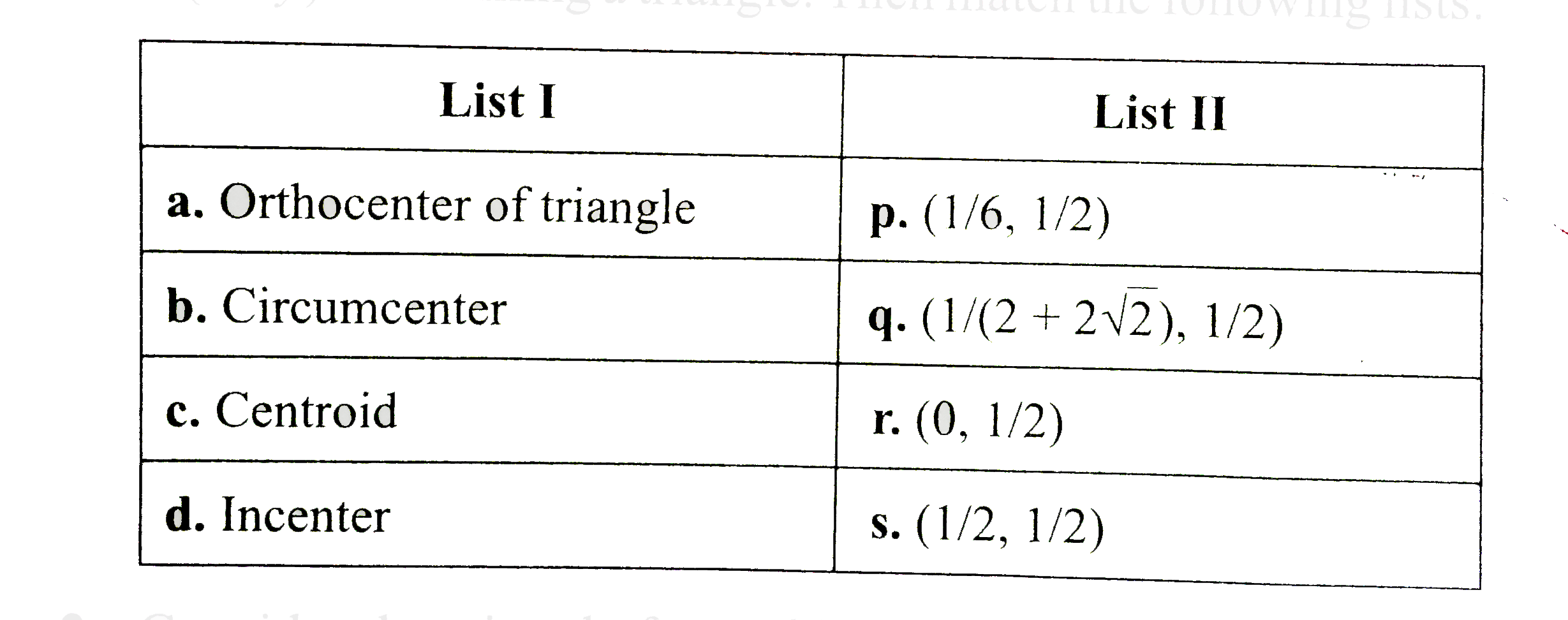A variable line L is drawn through O(0,0) to meet the line L1 and L2 given by y-x-10 =0 and y-x-20=0 at Points A and B, respectively.
Locus of P, if OP2=OA×OB, is Solution in Tamil
(y−x)2=100
(y+x)2=50
(y−x)2=200
none of these
The correct Answer is:C
r2=10×20(sinθ−cosθ)2
or (rsinθ−r cosθ)2=200
Hence, the locus is (y−x)2=200.
Topper's Solved these Questions
- BOOK - CENGAGECHAPTER - STRAIGHT LINESEXERCISE - Exercise (Matrix)8videos
STRAIGHT LINES
- BOOK - CENGAGECHAPTER - STRAIGHT LINESEXERCISE - Exercise (Numerical)13videos
STRAIGHT LINES
- BOOK - CENGAGECHAPTER - STRAIGHT LINESEXERCISE - Exercise (Multiple)30videos
STRAIGHT LINES
- BOOK - CENGAGECHAPTER - STRAIGHT LINEEXERCISE - Multiple Correct Answers Type8videos
STRAIGHT LINE
- BOOK - CENGAGECHAPTER - THEORY OF EQUATIONSEXERCISE - JEE Advanced Previous Year9videos
THEORY OF EQUATIONS
Similar Questions
Consider the lines represented by equation (x2+xy−x)×(x−y)=0 forming a triangle. Then match the following lists:
 09:22View Solution
09:22View Solutionstraight line L with negative slope passes through the point (9,4) cuts the positive coordinate axes at the point P and W As L. Varies, find the minimum value of |OP|+|OQ| , where O is origin .
05:05View SolutionIf P is a point (x,y) on the line y=−3x such that P and the point (3, 4) are on the opposite sides of the line 3x−4y=8, then x>815 (b) x>85 y<−85 (d) y<−815
05:05View SolutionThe point P(α,α+1) will lie inside the triangle whose vertices are A(0,3),B(−2,0) and C(6,1) if
View SolutionQ. Let p and q real number such that p≠0,p2≠q and p2≠−q. if α and β are non-zero complex number satisfying α+β=−p and α3+β3=q, then a quadratic equation having αβ and βα as its roots is
05:30View Solutiona variable line L is drawn trough O(0,0) to meet the lines L_(1):y-x-10=0 and L_(2):y-x-20=0 at point A&B respectively.A point P is taken on line L the (1) if (2)/(OP)=(1)/(OA)+(1)/(OB) then locus of P is is (3) if (1)/((OP)^(2))=(1)/((OA)^(2))+(1)/((OB)^(2)) then locus of point P is:
View SolutionA variable line L=0 is drawn through O(0,0) to meet the lines L:x+2y-3=0 and L:x+2y+4=0 at points M and N respectively.A point P is taken on L=0 such that (1)/((OP)^(2))=(1)/((OM)^(2))+(1)/((ON)^(2)). Locus of P is
03:13View SolutionA variable line L=0 is drawn through O(0,0) to meet the lines L_(1):x+2y-3=0 and L_(2):x+2y+4=0 at points M and N respectively.A point P is taken on L=0 such that (1)/(OP^(2))=(1)/(OM^(2))+(1)/(ON^(2)), then locus of point P is
05:55View SolutionA variable line L is drawn through O(0,0) to meet the line L1 and L2 given by y-x-10 =0 and y-x-20=0 at Points A and B, respectively.
Locus of P, if OP2=OA×OB, is06:29View SolutionA straight-line L through the origin meets the lines x+y=1 and x+y=3 at P and Q respectively. Through P and Q two straight lines L1 and L2 are drawn, parallel to 2x−y=5 and 3x+y=5 , respectively. Lines L1 and L2 intersect at R, show that the locus of R as L varies, is a straight line
06:01View SolutionA variable line 'L' Passing through the origin cuts two parallel lines x-y+10=0 and x-y+20=0 at two points A and B respectively . If P is a point on line 'L' such that OA , OP, OB are in harmonic progression then the locus of P is
04:44View SolutionA variable line L is drawn through O (0,0) to meet the lines L 1 :y−x−10=0 and L 2 :y−x−20=0 at the points A and B respectively. A point P is taken on L such that OP 2 = OA 1 + OB 1 and P,A,B lies on same side of origin O. The locus of P is
08:04View SolutionA variable line L is drawn through O(0,0) to meet the line L1 and L2 given by y-x-10 =0 and y-x-20=0 at Points A and B, respectively.
Locus of P, if OP2=OA×OB, is a. (y+x)2=50 b. (y−x)2=200 c. (y−x)2=100 d. none of these05:21View SolutionA variable line L si drawn through O(0,0) to meet lines L1andL2 given by y−x−10=0andy−x−20=0 at point A and B, respectively.
A point P IS taken on L such that 2/OP=1/OA+1/OB. Then the locus of P is02:40View SolutionA variable line L si drawn through O(0,0) to meet lines L1andL2 given by y−x−10=0andy−x−20=0 at point A and B, respectively.
Locus of P, if OP2=OA×OB, is02:42View Solution

